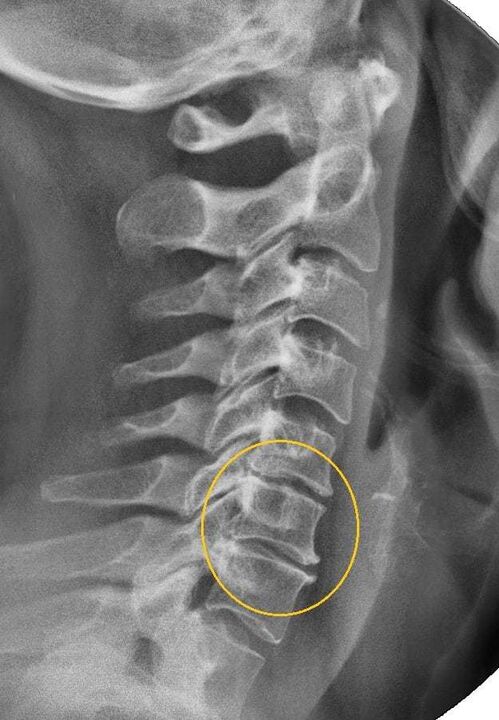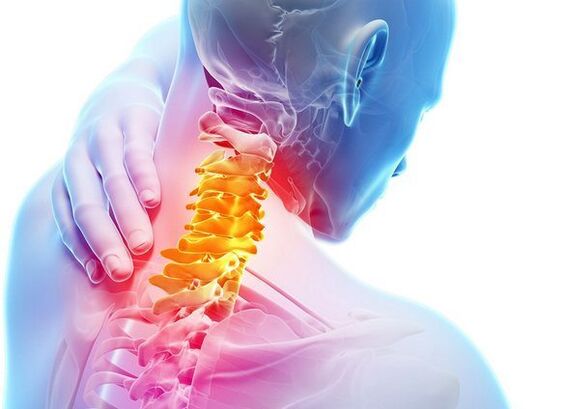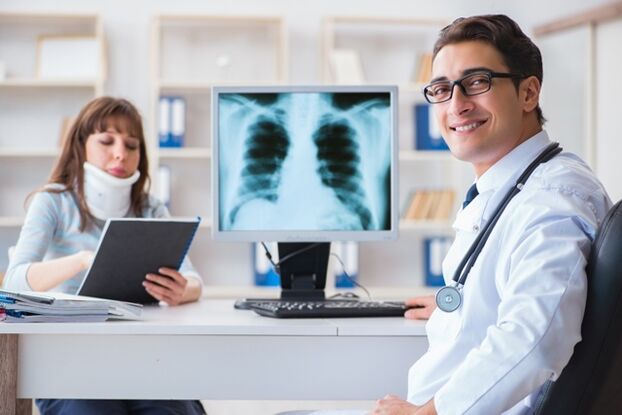Osteochondrosis is a general pathology of the spine characterized by a dynomic change in the structure of the cartilage contemporaries of the vertebrae and their bone basis. 
Up to one degree, osteochondrosis is manifested in most people after 30 years. The cervical osteochondrosis symptoms are varied, which often complicates diagnosis and subsequent treatment.
Causes of cervical osteochondrosis
Partly in the cervical column, there are many developments and progress of this pathology through the development of osteochondrosis of the cervical osteochondrosis, along the spinal column and the natural processes of body tissue aging:
- sedentary lifestyle;
- Long stay in the same situation during work;
- excess weight;
- Continuous spine injuries around the neck;
- chronic stress, constant nervous tension;
- Regular hypothermia of the collar zone muscles (for example, when it is close to air conditioning);
- Congenital spine and vertebrae discs.
General symptoms and signs of cervical osteochondrosis
The osteochondrous process simultaneously affects the spine or more. Lumbar and cervical vertebrae are mainly affected by pathologies because they are most prone to loads due to the anatomy of the human skeleton.
The consequences of the spine osteochondrosis in the cervical region cause the most discomfort and potential complications, since the neck is an area in which it is not rich in nerve highways, many of which are directly nourished by the brain.
Therefore, clinical symptoms with osteochondrosis of the cervix are related to the ischemia of the brain. In addition, nerve roots, which provide sensitivity and motor activity in the hands and shoulder belts, when squeezed with destroyed vertebrates can give a variety of symptoms. 
Signs of cervical osteochondrosis depend on which body systems are affected by pathology:
- Interrupted blood circulation due to compression of spinal arteries determines most of the symptomatic complexes from the brain.
- Compressing the roots that leave vertebrates gives you a picture of the lesion of peripheral nerves.
- Spinal cord areas are related to severe neurological pathologies in advanced cases.
Below are the general clinic of osteocondrosis of the cervical spine.
Pain on the back of the head, neck and collar
This is the most common symptom. The localization of the pain can be expanded, affecting the shoulders, the wrist range, the chest, and can become an intense head migraine.
The nature of the pain depends on the localization of the lesion and the severity of the pathology. At first, pain can be temporary, gradually chronic, sore.
In the moments of aggravation, pain becomes shooting, with increased sound of the cervical muscles and limited head movement.
Pain associated with osteochondrosis of the cervix can often be localized behind the sternum, in which case many patients take this symptom of angina pectoris. Differentiation can be performed with nitroglycerin taking a tablet - pain due to osteochondrosis and is not removed.
Noise, ringing, feeling of congestion in the ear
These symptoms are often joined to reduce hearing. These phenomena are associated with a reduction in blood flow from spinal arteries to vestibular.
The complex of these symptoms is called cochlear or snail syndrome, and it is still not possible to determine its relationship with osteochondrosis in the cervix region.
The specific property of differentiation is that noise, congestion and ring can be felt when the situation is changed, after a long stay in a long position.
Dizziness
Dizziness is also due to breaking the bloodstream of the organs of the inner ear, which ensures the balance of the body. Nystagm is often connected to dizziness - arbitrary fluctuations on the side of the observers.
Air shortage
This feeling appears due to irritation of the end of the membrane nerve. This is one of the components of the cervix's nerve beam and is involved in the regulation, depth and frequency of breathing. Patients complain that they cannot breathe in full chest.
In some cases, the symptom exacerbates severe shortness of breath and suffocation. For the same reason, breathing stops at night and snores.
The disadvantage of oxygen breathing problems is ultimately the cause of increased fatigue, concentration and memory problems.
Nausea
Accompany the air. In some areas of the brain and inner ear, it is also due to blood circulation problems. Nausea is sometimes observed with unobtrusive vomiting provoking the movement of the head and body. Frequent nausea and vomiting are the result of appetite, weight loss, and nutritional failure.
The problems of vision
"Flies" in the eyes, a decrease in visual acuity, the fog before the eye - these are all symptoms of the brain area due to ischemia, which is responsible for vision.
Patients with osteochondrosis complain less often because the lack of blood supply from the spine compensates the bloodstream of the carbon arteries system.
Eye muscles glasses and therapeutic gymnastics do not solve the problem, usually vision improves after the treatment of osteochondrosis.
Blood pressure
The degree of unstable pressure in the elongated brain is due to the blood flow, which is responsible for the function of the vascular motor center.
Sudden fainting or syncopal states
It occurs with cramps of the brain arteries because short -term blood flow is short -term stopping along the spine arteries.
From the state of losing the patient's consciousness, it can be quickly removed so that the legs are slightly higher than the head - the flow of blood to the brain allows a person to lead to life.
After an attack after the fainting, speech and reversible problems can be observed for a while due to a brief shutdown of blood flow.
Greenish symptoms
Often this can be the only sign that indicates the cervix osteochondrosis. They are expressed as sweat, drought and a lot of feelings in the throat, difficulties in swallowing. The symptoms are accompanied by compression of the nerve plexus responsible for the innervation of the pharynx. Such manifestations should be distinguished from a similar clinic due to inflammation or tumor.
Raising body temperature
The increase in the body temperature of the cervical -oseochondrosis is not the most common symptom, rarely and locally observed: in the cervical and collar areas, with slight redness of the skin.
First of all, the clinic of osteocondrosis of the cervical spine may be of different severity, depending on the stage of the pathology, and is lighter during the aggravation period, and for the second time to develop in certain syndromes.
Symptoms depending on the stages of the cervix osteochondrosis
Section I
The beginning of degenerative processes in the cartilage of the spinal boards. The symptoms are weak, sometimes not observed at all. The first signs of osteochondrosis of the cervical spine:
- Cervical discomfort, arms, shoulders, sometimes become pain;
- headache;
- easy restriction of neck motor activity;
- rapid transfer of visual impairment;
- Reducing the sensitivity of the collar area.
Important: These symptoms become more pronounced as the head decision.
As a general rule, in the first phase of osteochondrosis of the cervix region, patients do not go to a doctor, thinking that all symptoms are associated with fatigue, stress, age, and lack of sleep.
II. Platoon
At this stage, vertebrates' protrusion began, the intervertebral cracks are narrow, and the collagen fiber of the fibrous ring of the plate is destroyed. Due to the compression of the nerve cells, there are noticeable, painful symptoms that increase during the cervical movement and increase during the turns of the head. Here you can suspect the cervix osteochondrosis, which is as follows in the second stage:
- pronounced pain in the neck, sometimes crunching;
- The skin of the shoulders and hands almost completely loses sensitivity;
- Headaches are frequent and do not pass for a long time;
- visual impairment in the eyes of "flies";
- ringing and noise in the ear;
- weakness of the upper limbs;
- The clarity of tendon reflexes decreases;
- pain relief with a dedication under the blade;
- Feeling of sore throat, problems with swallowing;
- Sleep disorders, usually insomnia.
Long head holding in a situation leads to severe pain. At this stage of the disease, patients are seeking medical attention.
III.
The fibrous ring on the plate is destroyed and a hernia is formed. In the third stage, the spine, displacement and vertebrae displacement and dislocation are due to their poor fixation. Symptoms are as follows:
- intense, acute pain in the neck, collar zone, heart area;
- The sensitivity of the scalp on the back of the head, in the shoulder region, in the hands, until the complete absence;
- damaged the cervix's spine;
- paresis and paralysis of the upper limbs;
- Tendular reflexes were practically not observed.
This is a serious stage of the disease in which the patient is no longer able to support his head. Compression of spinal cord and spinal arteries leads to paralysis and parachis in other parts of the body and in the spinal cord.
Syndromes caused by the cervical spine osteochondrosis
Non -specific and various symptoms accompany the cervical spine osteochondrosis, and many different symptoms make it difficult to diagnose and further treatment, as some may be a sign of completely different diseases. Symptoms of cervical osteochondrosis are formed in groups called syndromes. Their presence and severity can indicate the pathology of the cervical spine with updated localization.
A group of syndromes often found:
Koreshka. Otherwise, it is called cervical ramulitis. It combines symptoms related to the root of the cervix. In the affected area, "gooseabumps", fingers, forearms, forearms, skin blunt and tingling on certain fingers.
Irrititive reflex. Burning and acute pain in the back of the head and neck, sometimes returning to the chest and shoulder, which occurs at the moment of changing the position of the head and neck, sneezing, coughing and sharp turning.
The spine arterial syndrome includes:
- headache, blows or constantly pulsating;
- inconvenience in certain movements, including a long static situation;
- weakness, nausea, loss of awareness;
- Reduction of hearing, equilibrium problems;
- Reducing visual acuity.
Heart. Angina pectoris almost the same image often leads to inadequate diagnosis and treatment. The syndrome appears due to irritation of diaphragmatic nerve receptors, partly captivating pericardium and a large chest muscle. Thus, in the heart region, cramps are more reflexes than an overview of cervical nerve irritation. Symptoms:
- Sudden start, prolonged pain, increasing the sharp movement of the neck, coughing, sneezing, not advancing the heart medication.
- The ECG does not show damaged blood flow to the heart muscle.
- Occasionally there can be extrasystole and tachicardia.
Vegetative-dibolic syndrome. Subluxus The first vertebrae of the cervix departure can lead to the formation of vegetation-vein dystonia. This is not a certain diagnosis of VVD because it has no pronounced symptoms.
There may be neurological symptoms, symptoms of damaged cerebral blood flow, intracranial pressure, muscle cramps.
As a result, the patient's complaints lead to dizziness, a reduction in visual acuity, loss of awareness, headache and nausea.
How to treat the cervix osteochondrosis
The spine described is a very severe pathology that leads to carelessness and leads to the deep disorders of cerebral circulation and death. Therefore, with medication on its own, if such symptoms occur, you should not do it.
Osteochondrosis is treated only as a doctor's prescription at home.
In the initial stages, the treatment of osteochondrosis of the cervix is conservative, including the drug recipes: non -steroid anti -inflammatory drugs, anesthesia, hormonal drugs, vitamin complexes, conditioners -all relieve inflammation, pain, and improve the trophic and portrait of soft tissue. 
During the acute period, drugs are prescribed in the form of injections, as soon as the pain disappears, the patient goes to tablets. Physiotherapy, massage, exercise exercises that are usually prescribed during the remission phase are connected to drug course. In difficult cases, osteochondrosis is treated with surgery.
Prevention
The health of the cervical spine is based on a strong and healthy back, physical activity, comfortable bed with anatomical pillows and mattresses, proper posture and proper nutrition.
It is worth avoiding cervical injuries and weight lifting. The prolonged seat and warm periods should be combined.
To predict the recovery
The prediction of qualified and timely treatment is favorable, but highly depends on the age of the patient, the severity of the manifestations and the stage of the disease. It is also important for a person to make medical recommendations on nutrition, lifestyle and eliminates bad habits.
Conclusion
Thus, in most cases, osteochondrosis of the cervix region can be cured. However, it is worth remembering that the disease can return at any time. To prevent this, you should pay attention to prevention measures and a healthy lifestyle.
In addition, it is worth remembering:
- The cause of osteochondrosis is difficult to determine.
- The symptom of the disease is pain in the back of the head and neck.
- Cervical osteochondrosis is treated comprehensively: drugs (primarily NSAIDs), massages, exercise therapy.























